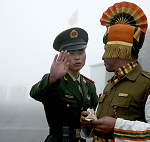Both are hard-core nationalists leading two Asian giants. However, the two countries have been not-so-good neighbours, largely because of a contentious border. At the same time, both Xi and Modi are known pro-business leaders who would walk the extra mile for the economic gain of their respective countries. And both understand the importance of mind games in India-China ties, which has clearly emerged as one of the most dynamic, doubted, and promising relations among any two nations in the world today. Therefore, when President Xi Jinping arrived in India on a three-day visit on September 17 and engaged in informal and formal talks with Prime Minister Narendra Modi, the world watched with interest.
If Xi was the first Chinese head of state to visit India in eight years, Modi became the first Indian PM to receive a visiting dignitary outside of New Delhi. The very fact that Xi and his superstar singer wife Peng Liyuan touched down at Ahmedabad to be personally received by the Indian leader indicated the flexibility at Modi’s disposal to pursue a new brand of diplomacy, largely due to the absence of a coalition string in his government.
India began with a display of its soft power in the form of a cultural extravaganza on the Sabarmati river front. But during the official talks in Delhi the next day, Modi made it clear to the Chinese leader that peace and tranquility along the border was essential to build mutual trust and confidence, a near echo of former PM Manmohan Singh’s words to Chinese premier Li Keqiang during his visit to India in May 2013.
However, India under the new dispensation did not fight shy of confronting the Chinese leader on the latest transgression by the Chinese army and civilians in the Chumar area in Jammu and Kashmir’s Ladakh frontier. By seeking a ‘clarification on the Line of Actual Control’, Modi indicated that he wanted to depart from the status quo on the boundary issue and bring Beijing to a hands-on dialogue.
Xi’s response was on the lines of that made by top Chinese leaders in the past. He said that as the border was yet to be demarcated, there were ‘certain incidents’ at times which the two nations have been able to manage down the years. Xi added that China was keen to ‘settle the boundary question at an early date’ and would maintain peace until that time.
Peace and tranquility have become relative terms in the context of the situation along the Chinese frontier. Statistics in Parliament say that the Chinese have transgressed into Indian territory 426 times in 2012, 411 times in 2013, and 334 times until August 4 this year. What is surprising is Xi’s inability as the commander of the Chinese military to stop such transgressions – even during his visit to India.
If Beijing was rattled by India-U.S. cooperation in the Asia Pacific region or Delhi cozying up to Tokyo, Modi may be looking to large Chinese investments in India to create manufacturing jobs for millions of young Indians – one of his major election promises. In just seven years, between 2004 and 2011, China generated 16 million manufacturing jobs, over and above an existing 112 million.
In contrast, India could create only 3 million. According to estimates, 6.5 million Indians are expected to join the workforce every year until 2030. By way of possible cash flow to India, the two countries have signed 12 agreements during this visit – one of them will see China investing $20 billion in India’s infrastructure over five years. The key areas where this is targeted include:
• Upgrading the railway system with high-speed links and modern railway stations.
• Setting up industrial parks in Gujarat and Maharashtra (Rs 40,800 crore or $6.8 billion).
• Providing greater market access to pharmaceuticals and farm products.
What concerns Delhi most is India’s huge trade deficit with China despite the country being India’s biggest trading partner. The annual two-way commerce is more than $65 billion. However, the trade deficit with China has soared to over $40 billion from just $1 billion in 2001-02 -something the Modi government wants to reverse. China may well come to India’s aid in a bid to cement ties at a time when there is heightened tensions with Japan and several South East Asian nations over maritime disputes.
India is aware of Beijing’s predicament and could try to leverage things. President Xi’s visit could actually reset India-China ties, but going by precedence one expects Delhi to pursue a policy of cautious optimism.
Wasbir Hussain is Executive Director of the Centre for Development & Peace Studies, Guwahati. A two-time former member of India’s National Security Advisory Board, Hussain has been writing and commenting on peace, security and development issues relating to India’s Northeast and its neighbourhood.
This article was exclusively written for Gateway House: Indian Council on Global Relations. You can read more exclusive content here.
For interview requests with the author, or for permission to republish, please contact outreach@gatewayhouse.in.
© Copyright 2014 Gateway House: Indian Council on Global Relations. All rights reserved. Any unauthorized copying or reproduction is strictly prohibited


